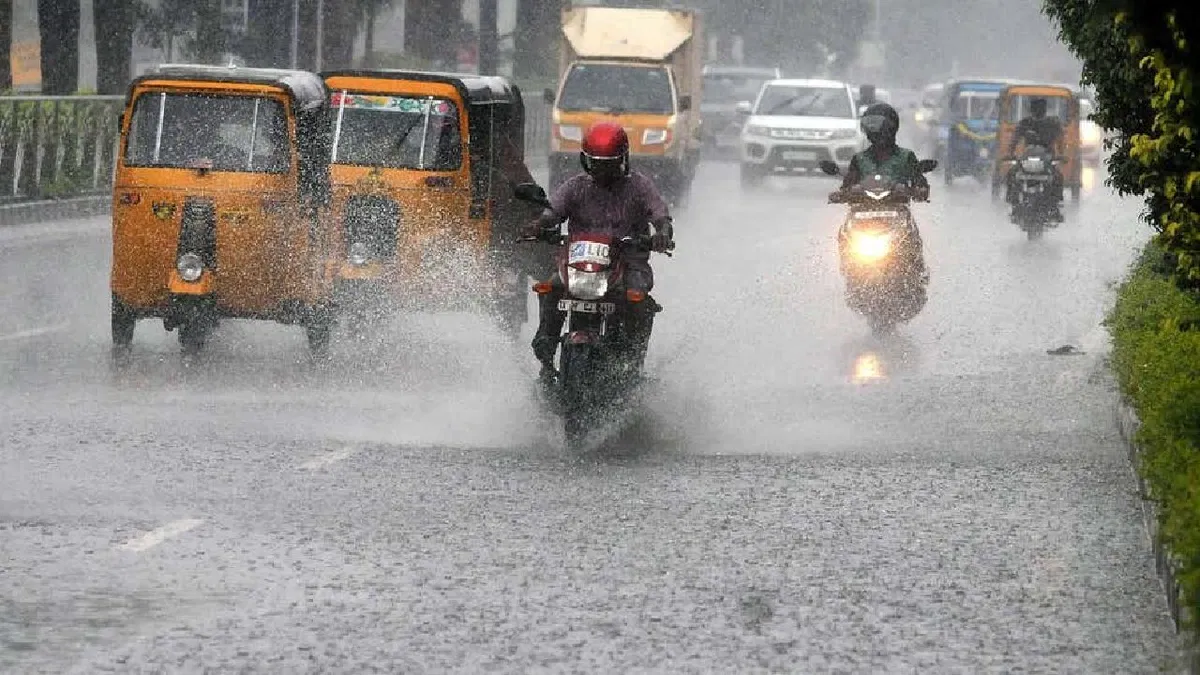The India Meteorological Department (IMD) has issued an orange-level rainfall alert for Tamil Nadu, indicating a phase of intense rainfall and gusty winds between August 3 and 5, 2025. This alert is part of the broader active monsoon conditions sweeping across southern India, including neighbouring regions like Kerala and Mahe. Residents are urged to stay vigilant and take appropriate precautions.
What Triggered the Orange Alert?
According to the IMD’s bulletin released on August 1, 2025, a developing upper air circulation system and an active monsoon trough are the main causes of the expected heavy rainfall. These meteorological features often result in strong, consistent downpours, especially over coastal and interior regions of Tamil Nadu.
The IMD’s forecast indicates isolated very heavy rainfall in Tamil Nadu between August 2 and 8, with peak intensity expected between August 3 and 5. Wind speeds of 40 to 50 km/h are also expected to sweep across parts of South Peninsular India during this period.
Understanding the Orange Alert
An orange-level weather alert is issued when heavy to very heavy rainfall is forecasted along with the likelihood of thunderstorms, lightning, or strong winds. While not as severe as a red alert, it still signals a significant threat that demands preparation and caution from both citizens and government authorities.
Daily Forecast: August 3 to 5
Here’s a breakdown of the expected weather activity:
- August 3 (Day 2): Tamil Nadu, Puducherry, and Karaikal will experience heavy to very heavy rainfall. Isolated thunderstorms and gusty winds are likely.
- August 4 (Day 3): The rainfall pattern will continue with similar intensity, with thunderstorms and strong winds expected to accompany the downpours.
- August 5 (Day 4): Rainfall will persist, though intensity may reduce slightly. Isolated thunderstorms and winds up to 50 km/h are still anticipated.
Meanwhile, Kerala and Mahe are forecast to receive their peak rainfall around August 6 and 7.
Impact on Daily Life in Tamil Nadu
1. Urban Flooding & Waterlogging
The risk of waterlogging in urban and low-lying areas increases, especially in cities like Chennai. Inadequate drainage systems could exacerbate the situation, leading to localised flooding.
2. Transport Disruptions
Heavily waterlogged streets may hinder road traffic. Rail and air travel could also face delays or cancellations, especially during peak rainfall hours. Commuters are advised to check for real-time updates before travelling.
3. Agricultural Concerns
Excessive rain could damage standing crops and delay sowing or harvesting activities. Saturated soil also raises the risk of flash floods in agricultural zones.
4. Damage to Structures
Gusty winds may weaken temporary or thatched-roof structures. Trees and hoardings near roads may also pose a risk if uprooted by strong winds.
5. Power and Communication Issues
Temporary power outages and disruptions in mobile or internet services may occur due to heavy rain and wind-related damage.
Safety Precautions for Residents
Authorities and residents are encouraged to take the following steps:
- Avoid unnecessary travel, especially in flood-prone areas.
- Secure loose outdoor items to prevent them from being blown away.
- Store essential supplies such as drinking water, dry food, flashlights, and batteries.
- Charge all devices and keep power banks handy.
- Stay away from water-logged zones and avoid entering underpasses.
- Avoid sheltering under trees or near electric poles during thunderstorms.
Community leaders and local bodies should ensure that stormwater drains are cleared and emergency response teams are on standby.
Coastal and Fishing Warnings
Fisherfolk along the Tamil Nadu coast are advised not to venture into the sea during this period due to expected strong winds and rough sea conditions. All coastal activities, including boat operations and recreational water sports, should be postponed until conditions normalize.
Wider Regional Outlook
- Kerala & Mahe: Heavy to very heavy rainfall is forecasted between August 2 and 7, with a peak around August 6–7.
- Andhra Pradesh, Telangana, and Karnataka: These states may see moderate to isolated heavy showers from August 5 onward.
Strong surface winds are predicted to impact all parts of South Peninsular India, prompting a general advisory for safety and preparedness across the region.
Why This Alert is Significant
- Timing of the Rainfall: This alert comes at a time when monsoon patterns are usually stabilising, making these early August downpours noteworthy.
- Urban Infrastructure: Tamil Nadu, especially Chennai, often struggles with stormwater drainage and urban planning issues. Sudden, intense rain may quickly overwhelm existing systems.
- Drought-Alleviating Potential: While the rain might temporarily disrupt life, it also replenishes water bodies and supports agriculture in rain-fed regions.
- Preparedness Challenges: High population density and poor urban planning increase the difficulty of emergency response efforts.
Key Dates to Watch
| Date | Alert Level | Expected Weather Conditions |
|---|---|---|
| August 3 | Orange Alert | Heavy rain, thunderstorms, strong winds |
| August 4 | Orange Alert | Persistent showers, gusty winds, urban flooding risk |
| August 5 | Continuing Warning | Reduced intensity but persistent rain and winds |
Looking Beyond August 5
The IMD predicts that heavy monsoon activity may begin to decline after August 7. Rainfall will continue but in a more distributed and less intense manner across Tamil Nadu and the surrounding states. Meanwhile, eastern and northeastern India may begin experiencing their own spells of heavy monsoon activity.
Final Thoughts
The orange alert issued for Tamil Nadu from August 3 to 5 serves as a reminder of nature’s unpredictability. While rainfall brings benefits like agricultural support and groundwater recharge, it also demands caution and preparedness. Both authorities and the public must work together to mitigate potential risks.
Staying updated with official weather reports, acting promptly on advisories, and being aware of local emergency contacts can go a long way in ensuring safety during such intense weather events.
Preparedness is not just the job of the government—it’s a shared responsibility.










